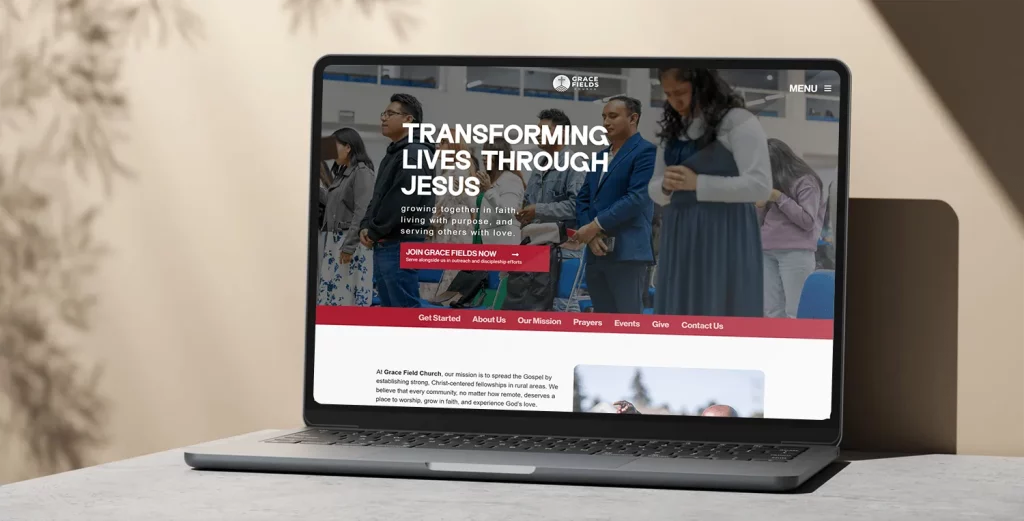In the modern world, having a website is no longer a luxury but has become a necessity. Whether you’re a church or a business, having a website gives you a much-needed online presence. While no recent studies have been done, a 2010 Faith Communities Today (FACT) report found that 70% of U.S. congregations had websites, based on a survey of over 11,000 congregations across more than 120 denominations. That number has likely increased significantly, especially in the wake of the 2022 pandemic.
However, simply having a website isn’t enough, it needs to be engaging and tailored to your ministry’s needs. Unfortunately, this is where a lot of churches fail because mastering church website development is not easy. You need the right knowledge to expertly design an exceptional website.
This church website guide will walk you through the step-by-step process of creating a beautiful website that is functional, engaging and tailored to your church’s unique mission.
Why Your Church Needs a Stellar Online Presence
Before we get into the nitty-gritty of how to design a church website, we need to address just why exactly your church needs one. It’s not just because digital presence is a trend, but a website offers significant benefits for churches.
Here are some of the key benefits:
- Digital front door:
At a time when over 17 million Americans choose to visit church websites instead of attending in person, your website is the digital extension of your congregation. It is crucial that you have a well-designed website that will act not only as a doorway to your church but also as a digital alternative for your congregation.
- Hub for Community Engagement
A church website can also function as a hub for church community events with features like donation portals, event calendars and sermon archives that will help to keep your members engaged, connected and informed. During the pandemic, more than 64% of American churches used their best church website tools to maintain an online presence that has lasted to 2025.
- Amplifies Outreach
Having a website also ensures that your ministry is not confined to your physical location, and certainly not only to Sundays. With the ability to upload sermons or full church services, people from all over the world can engage with your church’s content from their homes anytime. This extends your reach and amplifies the gospel far beyond your local weekly service. Now that you know exactly why you need to build a quality website for your church, here is a simple step-by-step church website blueprint.

Step 1: Define Your Goals for Church Website Development
Before you get into the actual design, Clarify your purpose. Are you aiming to attract a bigger online audience? Encourage online donation to stream services? Or do you want to simply be an information source for your congregation? Most churches want to do it all.
Write down your website’s specific goal and keep them in mind as you move forward. There are three key reasons churches build websites:
- Informational Intent: Share service times, location, and events.
- Transactional Intent: Enable members to donate online
- Navigational Intent: Help prospective new visitors find your church easily.
To ensure your website aligns perfectly with your ministry’s goals, you need expert guidance to bring your vision to life. Kingdom Web Services’ team works closely with you to identify your ministry’s priorities and craft a website that meets those needs, offering expert guidance and creative design ideas to bring your vision to life.
Step 2: Choose the Right Platform for Church Website Customization
Now that you know the purpose of your church website, you have to find the right tools for the job. Remember, your website will only be as good as the tools you use. There are quite a number of website builders for you to choose from.
However, while DIY website builders like WordPress or Wix often leave you without support, Kingdom Web Services takes a hands-on approach. We are a full-service web developer who will help you build your church website with exclusive church-focussed features and upgraded tools. Our real person support team will handle the technical details and deliver a site tailored to your preference.
Step 3: Secure a Domain and Hosting for Your Church Website
Next is to choose your domain, which is your digital address, like www.yourchurchname.com. You also need to choose reliable website hosting for churches to ensure that your website stays online with fast speeds and strong security.
- Domain Name Tips: Keep it short, memorable, and church-related. This will make it easier for members and visitors to find your website easily and encourages them to return
- Hosting Must-Haves: Look for hosting providers that offer 99.9% guaranteed uptime, and 24/7 support.
Choosing the right domain and hosting can be complex, but expert assistance simplifies the process. Kingdom Web Services simplifies the process of securing a short, memorable, church-related domain name. We also provide reliable hosting with 99.9% uptime, fast speeds, and robust security, so your website is always accessible and secure.
Step 4: Plan Your Church Website Essentials
What Features to Include in Your Church Website
With the basics covered, the actual church website development can start. It begins with selecting the right elements. Here are some church website essentials:
- Homepage: A welcoming message and clear call-to-action (e.g., “Join us Sunday!”).
- Service Times: Make them front and center.
- About Us: Share your mission and history.
- Events Calendar: Highlight upcoming gatherings.
- Sermons: Offer audio and video archives.
- Donation Page: Simplify online giving.
Selecting the right features requires a strategic approach to meet your church’s needs. Kingdom Web Services will help you with the perfect layout, from single-page websites to expansive multipage layouts, ensuring every essential element is perfectly tailored to your ministry.
Step 5: Design with Church Website Customization in Mind
Building websites isn’t all about aesthetics; user-friendliness matters most. A well-designed church website ensures that visitors are engaged the moment they arrive. For a good design, focus on the following:
- Mobile-Friendly Layout: Most of today’s web traffic (over 50%) comes from mobile devices It is vital that the website looks great on all devices.
- Consistent Color Scheme: The website theme should reflect your church’s identity.
- Simple Navigation: Use an intuitive menu (e.g., Home, About, Services, Contact).
Creating a design that’s both stunning and user-friendly requires professional expertise. Our team collaborates with you to create a visually appealing, easy-to-navigate site that captures the spirit of your church.
Step 6: Add Content That Engages Your Audience
Church Website Tips for Compelling Content
Now that the design is in place, you can start creating the website’s content. Strong content plays a crucial role in church website development;, you want to keep it concise and straight to the point:
- Welcome Message: Make it warm and personal.
- Photos: Use high-quality images of your congregation (with consent).
SEO Keywords: Include phrases that reflect your church like your church name, denomination, location and ministry names to help improve visibility in search engines such as google.
While you can learn to add your own content with our easy-to-use tools, our team is always available to make up to three content updates per month at no extra cost, ensuring your site stays fresh and relevant.
Step 7: Optimize Your Church Website for Search Engines
Boost Visibility with Church Site SEO
Even with the best content and design, you need help to ensure your church websites show up higher on Google search results and other search engines. That’s why you need to optimize your church website. Here are a few church website tips and tricks:
- Keywords: Include words like your church name, denomination, location and ministry names in headings and texts.
- Meta Tags: Write compelling titles and descriptions (see below).
- Alt Text: Add descriptions to images for accessibility and SEO.
Effective SEO requires specialized tools and expertise to maximize visibility. Our advanced SEO tools help your website rank higher, connecting you with more visitors.

Step 8: Test and Launch Your Church Website
Ensure a Smooth Church Website Best Practices Rollout
Before going live, test everything:
- Usability: Ask volunteers to navigate and provide feedback.
- Functionality: Check links, forms, and donation buttons.
- Speed: Use tools like Google PageSpeed Insights.
A flawless launch requires professional oversight to ensure everything works perfectly. Kingdom Web Services is with you every step of the way. Once perfected, we launch your site and help you share it with your congregation and community.
Step 9: Maintain and Update Your Church Online Presence
Keep Your Website Fresh with Church Website Marketing
After everything is set up, you will need to keep it fresh with new content and regular updates so it remains accessible and continues to deliver value:
- Events: Keep your calendar up to date with upcoming events.
- Sermons: Upload weekly messages.
- Analytics: Monitor your website’s performance by using tools like Google Analytics.
Ongoing maintenance can be daunting, but a dedicated partner keeps it manageable. Kingdom Web Services provides continuous support and advanced plugins to ensure your website grows with your church, helping you serve your community effectively.
Final Thoughts on Building the Perfect Church Website
Kingdom Web Services believes that creating the perfect church website doesn’t have to be overwhelming. Our full-service team delivers a fully customized, professional church website that reflects your ministry’s heart and mission. With real-person support, advanced tools, and a partnership approach, we help your church grow and connect with your community.
Ready to start? Visit kingdomwebservices.com today!.








